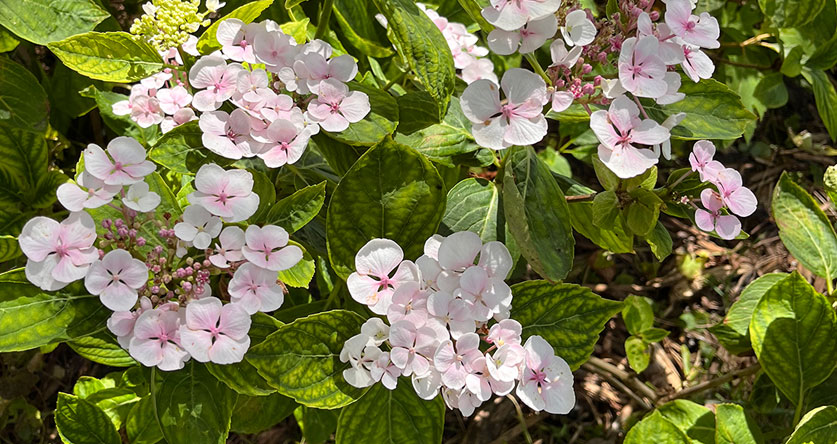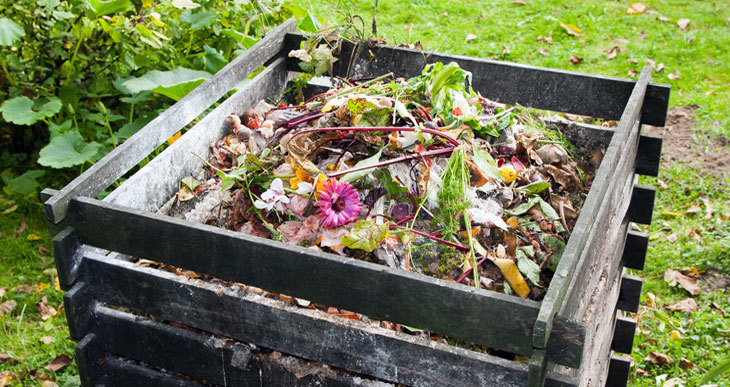Best Compost For Flower Beds (Garden Game Changer!)

If you’re reading this, you agree that compost is the best way to enrich your flower beds by providing essential nutrients for optimal plant growth and longevity.
However, there are many different compost types, either that you can make at home or buy commercially. So, knowing what you need can be a bit overwhelming.
In this article, I’ll examine the best compost options for flower beds to help all you avid gardeners get the best out of your gardens 🙂
What’s The Best Compost For Flower Beds?
Potassium-rich compost is ideal for flower production. However, the best compost for any situation is the one that rectifies a deficiency in the soil and improves the soil’s structure by adding organic material, encouraging soil biota, improving water retention, stability, and a slow release of nutrients.
There are few better smells than healthy, active soil, rich in organic materials, or when you dig into it and find wriggling earthworms 🙂
And to create healthy soil, effective composting is essential.
Compost should be made from organic substances (decaying plant material), with no contaminants or synthetic materials, which may introduce harmful chemicals to the soil.
While almost any compost is (generally) good for your garden, you may require more or less of a specific nutrient. Testing the soil before compositing is wise to determine any shortfallings. (Use a kit like this! – Amazon)
The original organic components used in the compost release various macro and micronutrients. Different types of compost are usually higher/lower in these nutrients, so if you are aware of a specific deficiency, you can aim to add a particular kind.
i.e., fertilizers have more than 1% N, while mulches and potting soil usually have less than 1% N. However, if there is a good balance between nitrogen, potassium, and phosphorus, your compost should be healthy.

Some of the most popular compost types include:
Homemade Compost (Yard Trimmings and Kitchen Scraps)
If you’re like me, you probably produce a shocking amount of kitchen waste daily. The great news is, this doesn’t have to be wasted!
Adding kitchen scraps (particularly plant-based materials) to your yard trimmings is a fantastic way to produce excellent compost as it increases the amount of nitrogen (N) present.
However, you’ll need a suitable balance between “green” and “brown” material (nitrogen vs. carbon); otherwise, the resulting compost may burn your flowers (a problem known as nitrogen burn).
Garden compost is suitable for almost all types of flowers, but choose the kind you use to compliment your soil type and align with the flowers you’re growing. For example, certain flowers prefer more acidic or alkaline conditions.
Some benefits of homemade compost include:
- It’s free.
- Composting organic materials is a responsible way to deal with household waste. It may even encourage you to reduce your waste output.
- When done correctly, homemade compost is a fantastic source of nutrients for your flower bed.
- You can “tweak” the potassium values by adding specific waste, like banana peels!
However, there are some drawbacks to homemade compost, including:
- The nutrients may vary and not have what your flower beds require.
- You may not produce enough compost to meet your needs.
- Composting takes time, so it’s a long-term investment.
Composted Pine Bark
Composted pine bark is an example of acidic (ericaceous compost)
It’s a good option for flower beds that prefer acidic soil conditions, like azaleas, rhododendrons, and certain hydrangeas. It improves soil health and drainage while slightly lowering the soil’s pH.

Mushroom Compost
Thanks to fungi’s innate decomposing abilities, compost produced by mushrooms is also ideal for your flower beds.
Many types of mushroom compost have a near-neutral pH and won’t drastically affect the soil’s alkalinity. This can be suitable for alkaline-loving flowers.
After harvesting, mushroom farms produce substantial amounts of “mushroom soil,” the leftover growing medium. This soil is packed full of nutrients.
The growing medium is a mixture of various organic materials, which are composted for roughly one month before growing mushrooms. After the “shrooms” go, this substrate is harvested and sold to the public.
The benefits of mushroom compost include:
- This compost has a lot of nutritional value and provides organic material to the soil.
- Disease and pest-free.
Some drawbacks of mushroom compost include:
- The nutrient composition may vary depending on the substrate.
- Some of the nutrients may harm sensitive flowers.
- Unfortunately, this compost may cost more than other types.
Worm Castings
If you’re interested in producing homemade compost, I recommend starting a worm farm. (Amazon). These wiggly little critters make short work of recycling organic scraps.
Overall, worm castings are microbially active, provide a slow release of nutrients, and are excellent for promoting the root health of your flowering plants. Worm castings are typically close to pH neutral and won’t significantly impact the soil’s alkalinity. They provide a gentle source of nutrients for alkaline-loving flowers.
Red wigglers are popular worms that eat kitchen and garden scraps and transform them into nutrient-rich castings (worm poop). While the compost’s composition depends on what you feed the worms, thanks to the worm’s digestive process, their castings are great for plants in most varieties.
Note: leachate is not the same as worm tea! Please be careful of the runoff produced by worm boxes. This liquid is potentially hazardous (nutrient concentrations and pathogens), and I recommend discarding it. Worm tea, on the other hand, is made using worm castings.
The benefits of worm castings as compost:
- Worms reproduce quickly. With proper management, they efficiently breed and consume.
- The castings make a fantastic “worm tea,” which has anti-bacterial/fungal properties and acts as a liquid fertilizer.
- A worm farm is a great family endeavor (especially if you have kids).
Some drawbacks include:
- Worms have a limited capacity. Unfortunately, you can “overfeed” your worms, which may lead to rot (trust me, it’s not a great smell).
- Worm castings are seasonal. Depending on your climate, most worms enter dormancy during colder weather.
- Farming worms is more effort than a regular compost heap.
Manure Compost
One type of highly prized compost is produced from manure (animal poop). Thanks to the digestive process of livestock (like cows and chickens), manure generally composts quicker and produces nutrient-rich compost.
However, when using composted manure for flower beds, ensure it is well-rotted to avoid excess nitrogen and potential nitrogen burn.
The benefits of manure compost:
- An excellent source of mulch thanks to its slow-release nature.
- It’s a fantastic source of nitrogen.
The drawbacks include:
- Sometimes, manure is too “fresh” and chemically burns your plants.
- You’ll need to purchase or find a way to transport this compost.
Mixed-Source Compost
Variety is the spice of soil life! I’ve found that the best compost is made from a mixture of various types of organic material (carbon and nitrogen-rich materials).
While nitrogen is essential for plant growth (the green parts), potassium promotes flower development, so a compost with higher potassium levels is ideal. Mixing manure with your kitchen and garden waste is a great way to produce good-quality mixed compost.
Here are some compost materials that can contribute to higher potassium content:
- Particular Fruit and Vegetable Scraps: Kitchen waste like banana peels, orange peels, and potato skins are relatively high in potassium. Including these materials in your compost can boost its potassium content.
- Wood Ash: Wood ash from hardwoods like oak contains significant amounts of potassium. However, use wood ash sparingly, as it can also raise the pH of the soil.
- Kelp and Seaweed: Seaweed and kelp are rich sources of potassium and other trace minerals.
- Legume Plants: Plants from the legume family, like beans and peas, tend to fix nitrogen in the soil, indirectly enhancing potassium availability.
- Potassium-Rich Amendments: Adding materials like greensand or sulfate of potash to your compost pile can increase its potassium content. These amendments are commonly used in organic gardening to improve potassium availability in the soil.
Best Bagged Compost For Flower Beds
There are a vast range of bagged compost products are designed to meet specific needs.
Some of the best products for flower beds include (Amazon links):
If you’re going the store-bought route, you’re saving a lot of time and effort in producing compost. And store-bought compost is usually tested, so you’ll better understand what you’re getting. Additionally, it’s readily available in practically any amount (e.g., if you have a lot of flower beds).
However, store-bought compost is more expensive than homemade, and its nutrient properties might not be 100% as “accurate” as what the store claims.
How To Improve Flower Beds’ Soil Quality

The best way to manage your flower bed is to arm yourself with knowledge. Before you add soil amendments, you need to determine the following.
- The type of soil in your flower bed.
- The nutrient deficiencies in the flower bed.
- The nutrient composition of your compost (homemade).
Once you’ve determined what you’re working with and what you need, you can start the amendments by improving the soil’s structure. Mixing organic compost into the soil is an excellent way to do this.
The benefit of compost is if you add a relatively low nitrogen (N) content compost, you shouldn’t hurt your garden, thanks to its slow-release nature.
Should You Use Compost or Mulch For Flower Beds?
Using compost vs. mulch is more clear-cut than you might expect.
- If you’re establishing a flower bed, I’d recommend using compost as it improves the soil quality (nutrient availability, structure, pH, biota, etc.) by mixing within the topsoil layer.
- Once your flower bed is established, you can add mulch as a “follow-up” treatment until you need to improve the soil again. Mulch sits on top of the earth and helps with water retention, weed control, etc.
Compost Vs. Topsoil For Flower Beds
Many new gardeners ask whether compost or topsoil is better for flower beds. The truth is, you need both!
Topsoil is not the same as compost. It’s a collection of the organic and inorganic components of the top 2 to 10″ of earth. Compost is decaying organic material mixed into this layer to give plants nutrients the topsoil may otherwise lack.
Topsoil acts as the growing medium, while compost is essential in improving the growing conditions for plants.
For example, if topsoil is the house, compost is the furniture and appliances that improve your home. You could live in the house without the extras, but you’ll only thrive once they’re added 🙂
Adding Compost To Flower Beds (How To)
When adding compost to the soil, start by preparing the flower beds.
- The best time to add compost is in the spring or fall.
- Remove any weeds present in the soil.
- Add the compost to the soil in an even layer. You’ll aim for a 20% compost/topsoil mixture. You’ll need to add between 1 and 3 inches of compost across the top of the soil.
- You can mix the compost with the top layer of soil or use a “no-till” approach and leave the compost on the surface.
- Water the soil-compost mix.
- After a week, you can begin planting flowers (depending on the type of compost added).
Remember that the specific needs of flowers can vary, so it’s a good idea to research the preferences of the particular flower species you’re growing.
Always aim for a balanced approach that promotes healthy plant growth without causing drastic shifts in soil composition.







